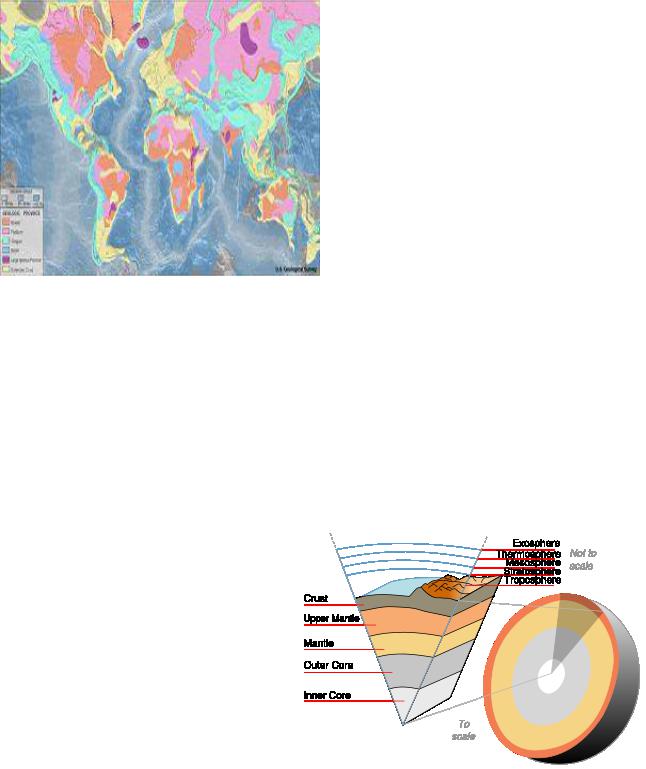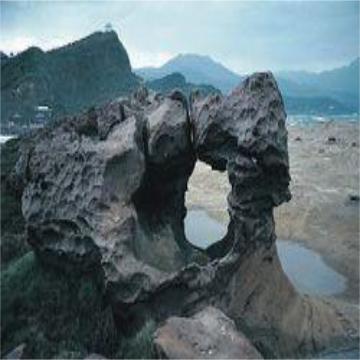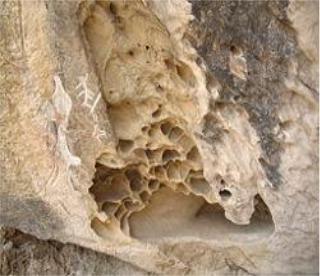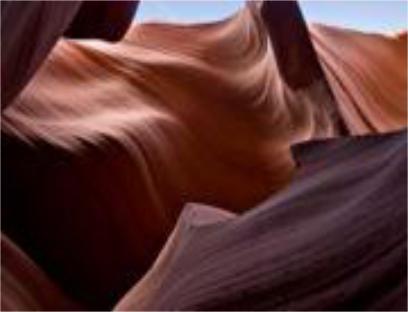
zhurova_t_v_angliiskii_yazyk_dlya_studentovgeologov (1)
.pdf
91
and these crusts are richer in incompatible elements than the underlying mantles. Crusts are also present on moons of outer planets and have formed by similar or analogous processes: for instance, Io, a moon of Jupiter, also has a crust formed by igneous processes.
Earth has the best characterized and perhaps the most complex crust of all the planets and moons in our solar system. An overview of our crust is provided in the entry on Structure of the
Earth, and the two contrasting types of crust are discussed in entries on continental crust and oceanic crust. Despite the detail known about Earth's crust, its early history is obscure. The rapidly growing base of knowledge about other bodies in the solar system provides insights into the beginnings of Earth history as well as into other possible paths of planetary evolution. Studies of the Moon have been particularly valuable for understanding the early Earth.
Earth's interior
A volcano is the release of stored energy from below the surface of Earth, originating from radioactive decay
and gravitational sorting in the Earth's core and mantle, and residual energy gained during the Earth’s formation.
Plate tectonics, mountain ranges, volcanoes, and earthquakes are geological phenomena that can be explained in terms of energy transformations in the Earth's crust.
Beneath the earth's crust lies the mantle which is heated by the radioactive decay of heavy elements. The mantle is not quite solid and
consists of magma which is in a state of semi-perpetual convection. This convection process causes the lithospheric plates to move, albeit slowly. The resulting process is known as plate tectonics.
Plate tectonics might be thought of as the process by which the earth resurfaces itself. Through a process called spreading ridges (or seafloor spreading), the earth creates new crust by allowing magma underneath the lithosphere to come to the surface where it cools and solidifies--becoming new crust, and through a process
92
called subduction, excess crust is pushed underground--beneath the rest of the lithosphere--where it comes into contact with magma and melts--rejoining the mantle from which it originally came.
Areas of the crust where new crust is created are called divergent boundaries, and areas of the crust where it is brought back into the earth are called convergent boundaries. Earthquakes result from the movement of the lithospheric plates, and they often occur near covergent boundaries where parts of the crust are forced into the earth as part of subduction.
Volcanoes result primarily from the melting of subducted crust material. Crust material that is forced into the athenosphere melts, and some portion of the melted material becomes light enough to rise to the surface--giving birth to volcanoes.
Earth's electromagnet
Current flowing around an iron core creates an electromagnet. Earth is an electromagnet.
An electromagnet is a magnet that is created by a current that flows around a soft-iron core. The earth has a soft iron core surrounded by semi-liquid materials from the mantle that move in continuous currents around the core; therefore, the earth is an electromagnet. This is referred to as the dynamo theory of earth's magnetism. The fact that earth is an electromagnet helps with the earth's maintenance of an atmosphere suitable for life.
Atmosphere
The magnetosphere shields the surface of the Earth from the charged particles of the solar wind. It is compressed on the day (Sun) side due to the force of the arriving particles, and extended on the night side.
The earth is blanketed by an atmosphere consisting of 99% oxygen and nitrogen. The atmosphere has five layers: troposphere, stratosphere, mesosphere, thermosphere, and exosphere; and 75% of the atmosphere's gasses are in the bottommost layer, the troposphere.
The magnetic field created by mantle's internal motions produces the magnetosphere which protects the earth's atmosphere from the solar wind. It is theorized that the solar wind would strip away earth's atmosphere in a few million years were it not for the earth's electromagnet. And since earth is 4.5 billion years old, earth would not have an atmosphere by now if there were no magnetosphere.
The atmosphere is composed of 78% nitrogen and 21% oxygen. The remaining one percent contains small amounts of other gasses including CO2 and water vapors. Water vapors and CO2 allow the earth's atmosphere to catch and hold the sun's energy through a phenomenon called the greenhouse effect. This allows earth's surface to be warm enough to have liquid water and support life.
In addition to storing heat, the atmosphere also protects living organisms by shielding the earth's surface from cosmic rays. Note that the level of protection seems

93
to be adjusted to prevent cosmic rays from destroying all life while allowing for the mutations that have an important role in pushing forward diversity in the biosphere.
Erosion
Erosion is displacement of solids (sediment, soil, rock and other particles) usually by the agents of currents such as, wind, water, or ice by downward or down-slope movement in response to gravity or by living organisms (in the case of bioerosion). There are two different types of erosion "mechanical erosion" and "chemical erosion" Each of these has a different effect on the environment. Mechanical erosion includes water, wind, sun, ice, natural disasters such as earthquakes and shoreline erosion. Chemical erosion would be acid rain, over use of fertilizer, human land use, deforestazation and overgrazing.
Erosion is distinguished from weathering, this is the process of chemical or physical breakdown of the
minerals in the rocks, although the two processes may be concurrent.
Erosion is an intrinsic natural process but in many places it is increased by human land use. Poor land use practices include deforestation, overgrazing, unmanaged construction activity and road or trail building. Land that is used for the production of agricultural crops generally experiences a significant greater rate of erosion than that of land under natural vegetation. This is particularly true if tillage is used, which reduces vegetation cover on the surface of the soil and disturbs both soil structure and plant roots that would otherwise hold the soil in place. However, improved land use practices can limit erosion, using techniques like terrace-building, conservation tillage practices, and tree planting.
A certain amount of erosion is natural and, in fact, healthy for the ecosystem. For example, gravels continuously move downstream in watercourses. Excessive erosion, however, does cause problems, such as receiving water sedimentation, ecosystem damage and outright loss of soil.
Approximately 40% of the world's agricultural land is seriously degraded. According to the UN, an area of fertile soil the size of Ukraine is lost every year because of drought, deforestation and climate change. In Africa, if current trends of soil degradation continue, the continent might be able to feed just 25% of its population by 2025, according to UNU's Ghana-based Institute for Natural Resources in Africa.
94
Causes
The rate of erosion tenses on many factors, including the amount and intensity of precipitation, the texture of the soil, the gradient of the slope, ground cover from vegetation, rocks, land use, how much water there is, and possibility of erosion from speed of a stream. The first factor, rain, is the agent for erosion, but the degree of erosion is governed by other factors.
The first three factors can remain fairly constant over time. In general, given the same kind of vegetative cover, you expect areas with high-intensity precipitation, sandy or silty soils and steep slopes to be the most erosive. Soils with a greater proportion of clay that receive less intense precipitation and are on gentle slopes tend to erode less. But here, the impact of atmospheric sodium on erodibility of clay should be considered (Schmittner and Giresse, 1999).
The factor that is most subject to change is the amount and type of ground cover. In an undisturbed forest, the mineral soil is protected by a litter layer and an organic layer. These two layers protect the soil by absorbing the impact of rain drops. These layers and the underlaying soil in a forest is porous and highly permeable to rainfall. Typically only the most severe rainfall and large hailstorm events will lead to overland flow in a forest. If the trees are removed by fire or logging, infiltration rates remain high and erosion low to the degree the forest floor remains intact. Severe fires can lead to significantly increased erosion if followed by heavy rainfall. In the case of construction or road building when the litter layer is removed or compacted the susceptibility of the soil to erosion is greatly increased.
Roads are especially likely to cause increased rates of erosion because, in addition to removing ground cover, they can significantly change drainage patterns. A road that has a lot of rock and one that is "hydrologically invisible" (that gets the water off the road as quickly as possible, mimicking natural drainage patterns) has the best chance of not causing increased erosion.
Many human activities remove vegetation from an area, making the soil easily eroded. Logging can cause increased erosion rates due to soil compaction, exposure of mineral soil, for example roads and landings. However it is the removal of or compromise to the forest floor not the removal of the canopy that can lead to erosion. This is because rain drops striking tree leaves coalesce with other rain drops creating larger drops. When these larger drops fall (called throughfall) they again may reach terminal velocity and strike the ground with more energy then had they fallen in the open. Terminal velocity of rain drops is reached in about 8 meters. Because forest canopies are usually higher then this, leaf drop can regain terminal velocity. However, the intact forest floor, with its layers of leaf litter and organic matter, absorbs the impact of the rainfall. (Stuart and Edwards)
Heavy grazing can reduce vegetation enough to increase erosion. Changes in the kind of vegetation in an area can also affect erosion rates. Different kinds of vegetation lead to different infiltration rates of rain into the soil. Forested areas have higher infiltration rates, so precipitation will result in less surface runoff, which erodes. Instead much of the water will go in subsurface flows, which are generally less erosive. Leaf litter and low shrubs are an important part of the high infiltration
95
rates of forested systems, the removal of which can increase erosion rates. Leaf litter also shelters the soil from the impact of falling raindrops, which is a significant agent of erosion. Vegetation can also change the speed of surface runoff flows, so grasses and shrubs can also be instrumental in this aspect.
One of the main causes of erosive soil loss in the year 2006 is the result of slash and burn treatment of tropical forest. When the total ground surface is stripped of vegetation and then seared of all living organisms, the upper soils are vulnerable to both wind and water erosion. In a number of regions of the earth, entire sectors of a country have been rendered unproductive. For example, on the Madagascar high central plateau, comprising approximately ten percent of that country's land area, virtually the entire landscape is sterile of vegetation, with gully erosive furrows typically in excess of 50 meters deep and one kilometer wide. Shifting cultivation is a farming system which sometimes incorporates the slash and burn method in some regions of the world.
Bank erosion started by four wheeler all-terrain vehicles, Yauhanna, South Carolina
When land is overused by animal activities (including humans), there can be mechanical erosion and also removal of vegetation leading to erosion. In the case of the animal kingdom, this effect would become material primarily with very large animal herds stampeding such as the Blue Wildebeest on the Serengeti plain. Even in this case there are broader material benefits to the ecosystem, such as continuing the survival of grasslands, that are indigenous to this region. This effect may be viewed as anomalous or a problem only when there is a significant imbalance or overpopulation of one species.
In the case of human use, the effects are also generally linked to overpopulation. For when large numbers of hikers use trails or extensive off road vehicle use occurs, erosive effects often follow, arising from vegetation removal and furrowing of foot traffic and off road vehicle tires. These effects can also accumulate from a variety of outdoor human activities, again simply arising from too many people using a finite land resource.
One of the most serious and long-running water erosion problems worldwide is in the People's Republic of China, on the middle reaches of the Yellow River and the upper reaches of the Yangtze River. From the Yellow River, over 1.6 billion tons of sediment flows into the ocean each year. The sediment originates primarily from water erosion in the Loess Plateau region of the northwest.
Soil Erosion and Climate Change
The consensus of atmospheric scientists is that climate change is occurring, both in terms of global air temperature and precipitation patterns. Warmer atmospheric temperatures associated with greenhouse warming are expected to lead to a more vigorous hydrological cycle, including more extreme rainfall events (IPCC, 1995). Karl and Knight (1998) reported that from 1910 to 1996 total precipitation over the contiguous U.S. increased, and that 53% of the increase came from the upper 10% of precipitation events (the most intense precipitation). The percent of


97
Two important classifications of weathering processes exist. Mechanical or physical weathering involves the breakdown of rocks and soils through direct contact with atmospheric conditions such as heat, water, ice and
pressure. The second classification,
chemical weathering, involves the direct effect of atmospheric chemicals, or biologically produced chemicals (also known as biological weathering), in the breakdown of rocks, soils and minerals.
The materials left over after the rock breaks down combined with organic material creates soil. The mineral content of the soil is determined by the parent material, thus a soil derived from a single rock type can often be deficient in one or more minerals for good fertility, while a soil weathered from a mix of rock types (as in glacial, eolian or alluvial sediments) often makes more fertile soil.
Physical (mechanical) weathering
Mechanical weathering is the cause of the disintegration of rocks. The primary process in mechanical weathering is abrasion (the process by which clasts and other particles are reduced in size). However, chemical and physical weathering often goes hand in hand. For example, cracks exploited by mechanical weathering will increase the surface area exposed to chemical action. Furthermore, the chemical action at minerals in cracks can aid the disintegration process.
Salt weathering of sandstone near Qobustan, Azerbaijan.
Thermal expansion
Thermal expansion, also known as onion-skin weathering, exfoliation, insolation weathering or thermal shock, often occurs in areas, like deserts, where there is a large diurnal temperature range. The temperatures soar high in the day, while dipping greatly at night. As the rock heats up and expands by day, and cools and contracts by night, stress is often exerted on the outer layers. The stress causes the peeling off of the outer layers of rocks in thin sheets. Though this is caused mainly by temperature changes, thermal expansion is enhanced by the presence of moisture.
98
Freeze thaw weathering
This process can also be called frost shattering. This type of weathering is common in mountain areas where the temperature is around freezing point.
Frost induced weathering, although often attributed to the expansion of freezing water captured in cracks, is generally independent of the water-to-ice expansion. It has long been known that moist soils expand or frost heave upon freezing as a result of water migrating along from unfrozen areas via thin films to collect at growing ice lenses. This same phenomena occurs within pore spaces of rocks. They grow larger as they attract liquid water from the surrounding pores. The ice crystal growth weakens the rocks which, in time, break up. Intermolecular forces acting between the mineral surfaces, ice, and water sustain these unfrozen films which transport moisture and generate pressure between mineral surfaces as the lens aggregates. Freeze induced weathering action occurs mainly in environments where there is a lot of moisture, and temperatures frequently fluctuate above and below freezing point—that is, mainly alpine and periglacial areas. An example of rocks susceptible to frost action is chalk, which has many pore spaces for the growth of ice crystals. This process can be seen in Dartmoor where it results in the formation of tors. When water that has entered the joints freezes, the ice formed strains the walls of the joints and causes the joints to deepen and widen. This is because the volume of water expands by 9% when it freezes. When the ice thaws, water can flow further into the rock. When the temperature drops below freezing point and the water freezes again, the ice enlarges the joints further. Repeated freeze-thaw action weakens the rocks which, over time, break up along the joints into angular pieces. The angular rock fragments gather at the foot of the slope to form a talus slope (or scree slope). The splitting of rocks along the joints into blocks is called block disintegration. The blocks of rocks that are detached are of various shapes depending on rock structure.
Pressure release
Pressure Release of granite.
In pressure release, also known as unloading, overlying materials (not necessarily rocks) are removed (by erosion, or other processes), which causes underlying rocks to expand and fracture parallel to the surface. Often the overlying material is heavy, and the underlying rocks experience high pressure under them, for example, a moving glacier. Pressure release may also cause exfoliation to occur.
Intrusive igneous rocks (e.g. granite) are formed deep beneath the earth's surface. They are under tremendous pressure because of the overlying rock material. When erosion removes the overlying rock material, these intrusive rocks are exposed and the pressure on them is released. The outer parts of the rocks then tend to expand. The expansion sets up stresses which cause fractures parallel to the rock surface to form. Over time, sheets of rock break away from the exposed rocks along the fractures. Pressure release is also known as "exfoliation" or "sheeting"; these processes result in batholiths and granite domes, an example of which is Dartmoor.
99
Hydraulic action
This is when water (generally from powerful waves) rushes into cracks in the rock face rapidly. This traps a layer of air at the bottom of the crack, compressing it and weakening the rock. When the wave retreats, the trapped air is suddenly released with explosive force. The explosive release of highly pressurized air cracks away fragments at the rock face and widens the crack itself.
Salt-crystal growth (haloclasty)
Salt crystallization or otherwise known as Haloclasty causes disintegration of rocks when saline (see salinity) solutions seep into cracks and joints in the rocks and evaporate, leaving salt crystals behind. These salt crystals expand as they are heated up, exerting pressure on the confining rock.
Salt crystallization may also take place when solutions decompose rocks (for example, limestone and chalk) to form salt solutions of sodium sulfate or sodium carbonate, of which the moisture evaporates to form their respective salt crystals.
The salts which have proved most effective in disintegrating rocks are sodium sulfate, magnesium sulfate, and calcium chloride. Some of these salts can expand up to three times or even more.
It is normally associated with arid climates where strong heating causes strong evaporation and therefore salt crystallisation. It is also common along coasts. An example of salt weathering can be seen in the honeycombed stones in sea wall. Like honeycomb weathering, Tafoni are related cavernous rock weathering structures believed made in large part by chemical and physical salt weathering processes.www.tafoni.com provides a comprehensive view of cavernous weathering processes including processes involving the chemical and physical effects of salt on rock.
Biological Weathering
Living organisms may contribute to mechanical weathering (as well as chemical weathering, see 'biological' weathering below). Lichens and mosses grow on essentially bare rock surfaces and create a more humid chemical microenvironment. The attachment of these organisms to the rock surface enhances physical as well as chemical breakdown of the surface microlayer of the rock. On a larger scale seedlings sprouting in a crevice and plant roots exert physical pressure as well as providing a pathway for water and chemical infiltration. Burrowing animals and insects disturb the soil layer adjacent to the bedrock surface thus further increasing water and acid infiltration and exposure to oxidation processes.
Chemical weathering
Chemical weathering involves the change in the composition of rocks, often leading to a 'break down' in its form. This type of weathering happens over a period of time.

Dissolution |
|
|
|
|
Rainfall |
is |
naturally |
||
slightly |
acidic |
|
because |
|
atmospheric carbon |
dioxide |
|||
dissolves |
in |
the |
rainwater |
|
producing |
weak |
|
carbonic |
|
acid. |
In |
|
unpolluted |
|
environments, |
the |
rainfall |
||
pH is around 5.6. Acid rain occurs when gases such as sulphur dioxide and nitrogen oxides are present in the atmosphere. These oxides react in the rain water to produce stronger acids and can lower the pH to 4.5 or even 3.0. Sulfur dioxide, SO2, comes from volcanic eruptions or from fossil fuels, can become sulfuric acid within rainwater, which can cause solution
weathering to the rocks on which it falls.
One of the most well-known solution weathering processes is carbonation, the process in which atmospheric carbon dioxide leads to solution weathering. Carbonation occurs on rocks which contain calcium carbonate such as limestone and chalk. This takes place when rain combines with carbon dioxide or an organic acid to form a weak carbonic acid which reacts with calcium carbonate (the limestone) and forms calcium bicarbonate. This process speeds up with a decrease in temperature and therefore is a large feature of glacial weathering.
Oil and gas geology
At about 60 degrees Celsius, oil begins to form in the source rock due to the thermogenic breakdown (cracking) of organic matter (kerogen).
The oil window is a temperature dependant interval in the subsurface where oil is generated and expelled from the source rocks. The oil window is often found in the 60-120 degree Celsius interval (aprox. 2-4 km depth), while the corresponding gas window is found in the 100-200+ degree Celsius interval (3-6 km depth).
After expulsion from the source rock, the oil and gas migrates upwards through permeable rocks (sandstones) or fractures until they are stopped by a tight, nonpermeable layer of rock, like shale. In this case, they are trapped, and may be
